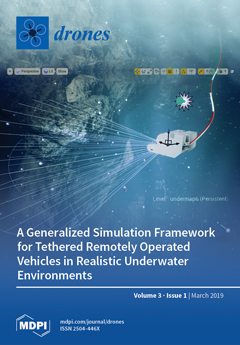Open AccessEditor’s ChoiceArticle
Implementation of a UAV–Hyperspectral Pushbroom Imager for Ecological Monitoring
by
J. Pablo Arroyo-Mora, Margaret Kalacska, Deep Inamdar, Raymond Soffer, Oliver Lucanus, Janine Gorman, Tomas Naprstek, Erica Skye Schaaf, Gabriela Ifimov, Kathryn Elmer and George Leblanc
Cited by 56 | Viewed by 9181
Abstract
Hyperspectral remote sensing provides a wealth of data essential for vegetation studies encompassing a wide range of applications (e.g., species diversity, ecosystem monitoring, etc.). The development and implementation of UAV-based hyperspectral systems have gained popularity over the last few years with novel efforts
[...] Read more.
Hyperspectral remote sensing provides a wealth of data essential for vegetation studies encompassing a wide range of applications (e.g., species diversity, ecosystem monitoring, etc.). The development and implementation of UAV-based hyperspectral systems have gained popularity over the last few years with novel efforts to demonstrate their operability. Here we describe the design, implementation, testing, and early results of the UAV-μCASI system, which showcases a relatively new hyperspectral sensor suitable for ecological studies. The μCASI (288 spectral bands) was integrated with a custom IMU-GNSS data recorder built in-house and mounted on a commercially available hexacopter platform with a gimbal to maximize system stability and minimize image distortion. We deployed the UAV-μCASI at three sites with different ecological characteristics across Canada: The Mer Bleue peatland, an abandoned agricultural field on Ile Grosbois, and the Cowichan Garry Oak Preserve meadow. We examined the attitude data from the flight controller to better understand airframe motion and the effectiveness of the integrated Differential Real Time Kinematic (RTK) GNSS. We describe important aspects of mission planning and show the effectiveness of a bundling adjustment to reduce boresight errors as well as the integration of a digital surface model for image geocorrection to account for parallax effects at the Mer Bleue test site. Finally, we assessed the quality of the radiometrically and atmospherically corrected imagery from the UAV-μCASI and found a close agreement (<2%) between the image derived reflectance and
in-situ measurements. Overall, we found that a flight speed of 2.7 m/s, careful mission planning, and the integration of the bundling adjustment were important system characteristics for optimizing the image quality at an ultra-high spatial resolution (3–5 cm). Furthermore, environmental considerations such as wind speed (<5 m/s) and solar illumination also play a critical role in determining image quality. With the growing popularity of “turnkey” UAV-hyperspectral systems on the market, we demonstrate the basic requirements and technical challenges for these systems to be fully operational.
Full article
►▼
Show Figures





